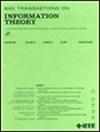有限字母分布源的非交互仿真
IF 2.9
3区 计算机科学
Q3 COMPUTER SCIENCE, INFORMATION SYSTEMS
引用次数: 0
摘要
这项工作提出了非交互源模拟(NISS)问题的傅里叶分析框架。两个分布式代理观察根据联合分布$P_{X^{d}Y^{d}}$绘制的一对序列$X^{d}$和$Y^{d}$。智能体的目标是生成输出$U=f_{d}(X^{d})$和$V=g_{d}(Y^{d})$,其联合分布的总变化量与目标分布$Q_{UV}$足够接近。现有的研究表明,具有有限字母输出的NISS问题是可确定的。对于二进制输出的NISS,导出了输入复杂度的上限为$O\left ({{\exp \mathrm {poly}\left ({{\frac {1}{\epsilon }}}\right)}}\right)$。在这项工作中,输入复杂性和算法设计在几种NISS场景中得到解决。对于具有双对称二进制输入的二元输出NISS场景,表明输入复杂度为$\Theta \left ({{\log {\frac {1}{\epsilon }}}}\right)$,从而提供了输入复杂度的超指数改进。给出了模拟函数对的显式表征。对于一般有限输入场景,引入了一种显式查找模拟函数$(f_{d}(X^{d}),g_{d}(Y^{d}))$的构造算法。该方法依赖于一种新颖的傅立叶分析框架。提供了具有IID输入的NISS场景的各种数值模拟。此外,为了说明傅里叶框架的一般适用性,提供了几个具有非iid输入的示例,包括纠缠辅助NISS和具有马尔可夫输入的NISS。本文章由计算机程序翻译,如有差异,请以英文原文为准。
On Non-Interactive Simulation of Distributed Sources With Finite Alphabets
This work presents a Fourier analysis framework for the non-interactive source simulation (NISS) problem. Two distributed agents observe a pair of sequences $X^{d}$ and $Y^{d}$ drawn according to a joint distribution $P_{X^{d}Y^{d}}$ . The agents aim to generate outputs $U=f_{d}(X^{d})$ and $V=g_{d}(Y^{d})$ with a joint distribution sufficiently close in total variation to a target distribution $Q_{UV}$ . Existing works have shown that the NISS problem with finite-alphabet outputs is decidable. For the binary-output NISS, an upper-bound to the input complexity was derived which is $O\left ({{\exp \mathrm {poly}\left ({{\frac {1}{\epsilon }}}\right)}}\right)$ . In this work, the input complexity and algorithm design are addressed in several classes of NISS scenarios. For binary-output NISS scenarios with doubly-symmetric binary inputs, it is shown that the input complexity is $\Theta \left ({{\log {\frac {1}{\epsilon }}}}\right)$ , thus providing a super-exponential improvement in input complexity. An explicit characterization of the simulating pair of functions is provided. For general finite-input scenarios, a constructive algorithm is introduced that explicitly finds the simulating functions $(f_{d}(X^{d}),g_{d}(Y^{d}))$ . The approach relies on a novel Fourier analysis framework. Various numerical simulations of NISS scenarios with IID inputs are provided. Furthermore, to illustrate the general applicability of the Fourier framework, several examples with non-IID inputs, including entanglement-assisted NISS and NISS with Markovian inputs are provided.
求助全文
通过发布文献求助,成功后即可免费获取论文全文。
去求助
来源期刊

IEEE Transactions on Information Theory
工程技术-工程:电子与电气
CiteScore
5.70
自引率
20.00%
发文量
514
审稿时长
12 months
期刊介绍:
The IEEE Transactions on Information Theory is a journal that publishes theoretical and experimental papers concerned with the transmission, processing, and utilization of information. The boundaries of acceptable subject matter are intentionally not sharply delimited. Rather, it is hoped that as the focus of research activity changes, a flexible policy will permit this Transactions to follow suit. Current appropriate topics are best reflected by recent Tables of Contents; they are summarized in the titles of editorial areas that appear on the inside front cover.
 求助内容:
求助内容: 应助结果提醒方式:
应助结果提醒方式:


